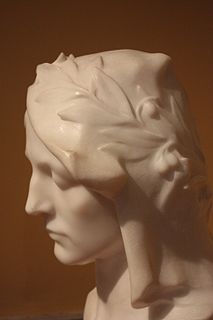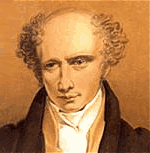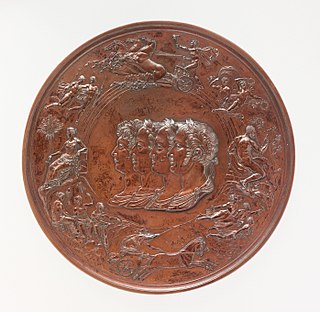Related Research Articles

William Wyon, was official chief engraver at the Royal Mint from 1828 until his death.

The sovereign is a gold coin of the United Kingdom, with a nominal value of one pound sterling. Struck from 1817 until the present time, it was originally a circulating coin accepted in Britain and elsewhere in the world; it is now a bullion coin and is sometimes mounted in jewellery. In most recent years, it has borne the design of Saint George and the Dragon on the reverse; the initials of the designer, Benedetto Pistrucci, are visible to the right of the date.

Benedetto Pistrucci was an Italian gem-engraver, medallist and coin engraver, probably best known for his Saint George and the Dragon design for the British sovereign coin. Pistrucci was commissioned by the British government to create the large Waterloo Medal, a project which took him thirty years to complete.
Thomas Wyon the Younger was an English medallist and chief engraver at the Royal Mint.

Allan Gairdner Wyon FRBS RMS was a British die-engraver and sculptor and, in later life, vicar in Newlyn, Cornwall.
George William de Saulles was a British medallist. He designed the obverse of coins of the United Kingdom and its colonies under Queen Victoria and King Edward VII.

It was announced in the London Gazette on 23 April 1816 that the Prince Regent had been graciously pleased, in the name and on the behalf of His Majesty, to confer The Waterloo Medal upon every officer, non-commissioned officer and soldier of the British Army who took part in one or more of the following battles: Ligny, Quatre Bras and Waterloo.

Leonard Charles Wyon was a British engraver of the Victorian era most notable for his work on the gold and silver coinage struck for the Golden Jubilee of Queen Victoria in 1887 and the bronze coinage of 1860 with the second ("bun") head portrait, in use from 1860 to 1894.

The Una and the Lion was a British £5 gold coin depicting Queen Victoria. It is recognized as one of the most beautiful British coins ever struck. It was designed by William Wyon in 1839, to commemorate the beginning of Queen Victoria's reign. The coins were first produced in 1839 and were probably intended for collector sets rather than for circulation. The production ran to a few hundred coins including a number of variations such as different metals, different hairbands on the depiction of the queen, different edge types, and a variation in the reverse inscription.
George Gammon Adams was an English portrait sculptor and medallist, noted for his statue of General Charles Napier in Trafalgar Square.

Allan Wyon (1843–1907) was an English medallist and seal-engraver.

Benjamin Wyon was a British engraver of seals, and medallist.
Joseph Shepherd Wyon was a British medallist and seal-engraver.
Thomas Halliday was an English coin and medal engraver associated with the Royal Birmingham Society of Artists.
Peter Wyon (1797-1822) was an engraver of medals and coins. He was born into a family who had a long tradition of dye-engraving. He was the son of George Wyon, as well as the brother of Thomas Wyon, with whom he went into business for a short time. Both his nephew, Thomas Wyon, and his son, William Wyon, held the position of Chief Engraver at the Royal Mint.

The Wyon family was an English family of traditional die-engravers and medallists, many of whom went on to work in prominent roles at the Royal Mint or as engravers in a family die business. Starting from Peter George (II) Wyon who migrated to England from Cologne, Germany many subsequent descendants of have made notable contribution to British numismatics. Over the course of the 19th-century two members of the family became Chief Engraver at the Royal Mint with many more involved in coin design.
Chief Engraver of the Royal Mint is a senior position at the British Royal Mint who is responsible for overseeing the preparation of coin dies.

The Waterloo Medal was designed by Italian-born sculptor Benedetto Pistrucci. He worked on it from 1819 to 1849, when the completed matrices were presented to Britain's Royal Mint. The medal was commissioned by the British Government in 1819 on the instructions of George IV while Prince Regent; copies were to be presented to the generals who had been victorious in the 1815 Battle of Waterloo, and to the leaders of Britain's allies. As most of the intended recipients had died by 1849, and relations with France had improved, the medals were never struck, though modern-day editions have been made for sale to collectors.

The double sovereign is a gold coin of the United Kingdom, with a nominal value of two pounds sterling or 40 shillings.

The London Mint Office is a British-based mail order company with headquarters in Camberwell, London that specialises in sourcing and producing commemorative coins, medals and banknotes. Established in 2006, The London Mint Office is part of the Samlerhuset Group., one of Europe's largest coin and medal companies, founded in 1994 and operating in 14 European countries.
References
- ↑ "Benedetto Pistrucci". Royal Mint Museum . Retrieved 29 June 2017.
- ↑ Challis, C. E. (1992). A New History of the Royal Mint. Cambridge University Press. p. 489. ISBN 978-0521240260.
- ↑ Farmer, Ben (11 November 2014). "Britain's Waterloo allies awarded medals – 199 years late". The Daily Telegraph . Retrieved 29 June 2017.
